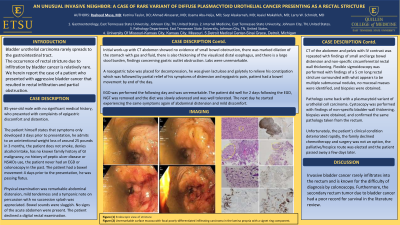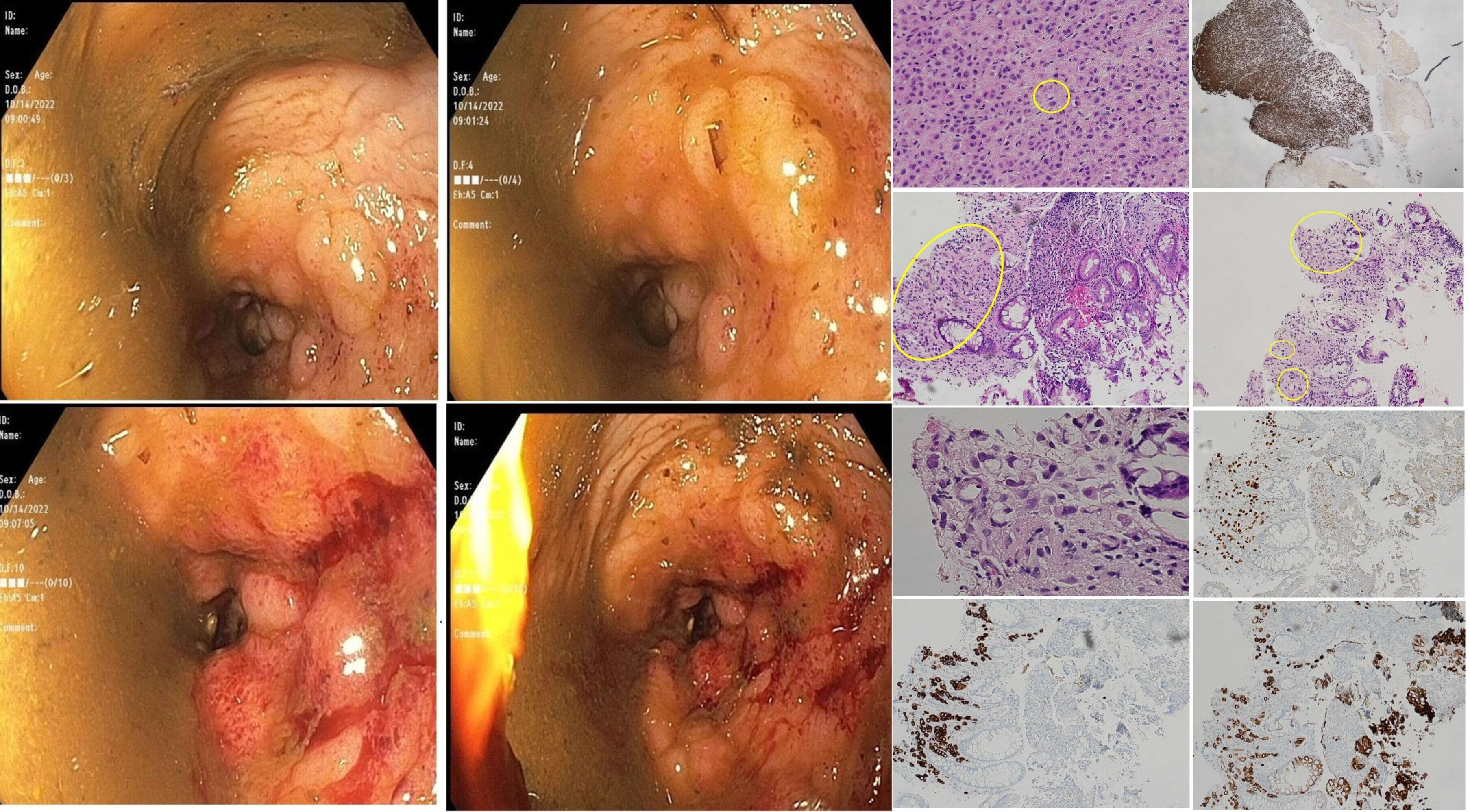Tuesday Poster Session
Category: Colon
P3146 - An Unusual Invasive Neighbor: A Case of a Rare Variant of Plasmacytoid Urothelial Cancer Presenting as a Rectal Stricture
Tuesday, October 24, 2023
10:30 AM - 4:00 PM PT
Location: Exhibit Hall

Has Audio
- RM
Rasheed Musa, MD
East Tennessee State University
Johnson City, TN
Presenting Author(s)
Rasheed Musa, MD1, Ahmad Alnasarat, MD2, Usama Abu-Heija, MBBS1, Saqr Alsakarneh, MD3, Asaiel Makahleh, MD4, Katrina Taylor, DO1, Lana Makahleh, MD1, Larry Schmidt, MD5
1East Tennessee State University, Johnson City, TN; 2Wayne State University/Detroit Medical Center/Sinai Grace Hospital, Detroit, MI; 3University of Missouri-Kansas City, Kansas City, MO; 4East Tennesse State University, Johnson City, TN; 5James H. Quillen VA Medical Center, Mountain Home, TN
Introduction: Bladder urothelial carcinoma rarely spreads to the gastrointestinal tract.
The occurrence of rectal stricture due to infiltration by bladder cancer is relatively rare. We herein report the case of a patient who presented with aggressive bladder cancer that resulted in rectal infiltration and partial obstruction.
Case Description/Methods: 85-year-old male with no significant medical history, who presented with complaints of epigastric discomfort, distention as well as unintentional weight loss of around 25 pounds in 3 months.
Physical examination was remarkable abdominal distension, mild tenderness and a tympanic note on percussion with no succession splash was appreciated. Bowel sounds were sluggish. No signs of the acute abdomen were present. The patient declined a digital rectal examination.
Initial work-up with CT abdomen showed no evidence of small bowel obstruction, there was marked dilation of the stomach with gas and fluid, there is also thickening of the visualized distal esophagus, and there is a large stool burden. Labs were unremarkable.
EGD was performed and was unremarkable. The patient did well for 2 days following the EGD, diet was slowly advanced and was well tolerated. The next day he started experiencing the same symptoms again of abdominal distension and mild discomfort.
CT of the abdomen and pelvis with IV contrast was repeated with findings of small and large bowel distension and non-specific circumferential rectal wall thickening. Flexible sigmoidoscopy was performed with findings of a 5 cm long rectal stricture surrounded with what appears to be multiple submucosal nodules, no mucosal masses were identified, and biopsies were obtained.
Pathology came back with a plasmacytoid variant of urothelial cell carcinoma. Cystoscopy was performed with findings of non-specific bladder wall thickening, biopsies were obtained, and confirmed the same pathology taken from the rectum.
Unfortunately, the patient’s clinical condition deteriorated rapidly, the family declined chemotherapy and surgery was not an option, the palliative/hospice route was elected and the patient passed away a few days later.
Discussion: Invasive bladder cancer rarely infiltrates into the rectum and is known for the difficulty of diagnosis by colonoscopy. Furthermore, the secondary rectum tumor due to bladder cancer had a poor record for survival in the literature review.

Disclosures:
Rasheed Musa, MD1, Ahmad Alnasarat, MD2, Usama Abu-Heija, MBBS1, Saqr Alsakarneh, MD3, Asaiel Makahleh, MD4, Katrina Taylor, DO1, Lana Makahleh, MD1, Larry Schmidt, MD5. P3146 - An Unusual Invasive Neighbor: A Case of a Rare Variant of Plasmacytoid Urothelial Cancer Presenting as a Rectal Stricture, ACG 2023 Annual Scientific Meeting Abstracts. Vancouver, BC, Canada: American College of Gastroenterology.
1East Tennessee State University, Johnson City, TN; 2Wayne State University/Detroit Medical Center/Sinai Grace Hospital, Detroit, MI; 3University of Missouri-Kansas City, Kansas City, MO; 4East Tennesse State University, Johnson City, TN; 5James H. Quillen VA Medical Center, Mountain Home, TN
Introduction: Bladder urothelial carcinoma rarely spreads to the gastrointestinal tract.
The occurrence of rectal stricture due to infiltration by bladder cancer is relatively rare. We herein report the case of a patient who presented with aggressive bladder cancer that resulted in rectal infiltration and partial obstruction.
Case Description/Methods: 85-year-old male with no significant medical history, who presented with complaints of epigastric discomfort, distention as well as unintentional weight loss of around 25 pounds in 3 months.
Physical examination was remarkable abdominal distension, mild tenderness and a tympanic note on percussion with no succession splash was appreciated. Bowel sounds were sluggish. No signs of the acute abdomen were present. The patient declined a digital rectal examination.
Initial work-up with CT abdomen showed no evidence of small bowel obstruction, there was marked dilation of the stomach with gas and fluid, there is also thickening of the visualized distal esophagus, and there is a large stool burden. Labs were unremarkable.
EGD was performed and was unremarkable. The patient did well for 2 days following the EGD, diet was slowly advanced and was well tolerated. The next day he started experiencing the same symptoms again of abdominal distension and mild discomfort.
CT of the abdomen and pelvis with IV contrast was repeated with findings of small and large bowel distension and non-specific circumferential rectal wall thickening. Flexible sigmoidoscopy was performed with findings of a 5 cm long rectal stricture surrounded with what appears to be multiple submucosal nodules, no mucosal masses were identified, and biopsies were obtained.
Pathology came back with a plasmacytoid variant of urothelial cell carcinoma. Cystoscopy was performed with findings of non-specific bladder wall thickening, biopsies were obtained, and confirmed the same pathology taken from the rectum.
Unfortunately, the patient’s clinical condition deteriorated rapidly, the family declined chemotherapy and surgery was not an option, the palliative/hospice route was elected and the patient passed away a few days later.
Discussion: Invasive bladder cancer rarely infiltrates into the rectum and is known for the difficulty of diagnosis by colonoscopy. Furthermore, the secondary rectum tumor due to bladder cancer had a poor record for survival in the literature review.

Figure: Endoscopic view of rectal stricture and histopathology
Disclosures:
Rasheed Musa indicated no relevant financial relationships.
Ahmad Alnasarat indicated no relevant financial relationships.
Usama Abu-Heija indicated no relevant financial relationships.
Saqr Alsakarneh indicated no relevant financial relationships.
Asaiel Makahleh indicated no relevant financial relationships.
Katrina Taylor indicated no relevant financial relationships.
Lana Makahleh indicated no relevant financial relationships.
Larry Schmidt indicated no relevant financial relationships.
Rasheed Musa, MD1, Ahmad Alnasarat, MD2, Usama Abu-Heija, MBBS1, Saqr Alsakarneh, MD3, Asaiel Makahleh, MD4, Katrina Taylor, DO1, Lana Makahleh, MD1, Larry Schmidt, MD5. P3146 - An Unusual Invasive Neighbor: A Case of a Rare Variant of Plasmacytoid Urothelial Cancer Presenting as a Rectal Stricture, ACG 2023 Annual Scientific Meeting Abstracts. Vancouver, BC, Canada: American College of Gastroenterology.
